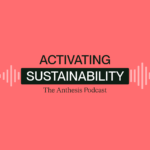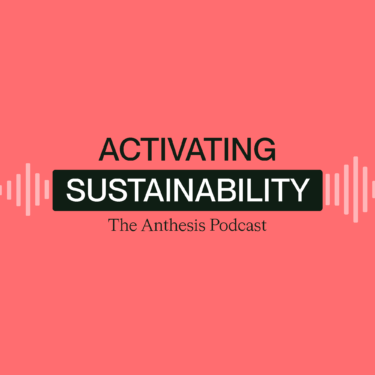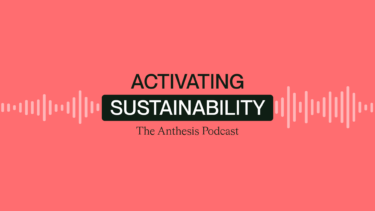
Speakers
Chris Peterson – Director, North America
Flore Fouret – Director, Climate and Nature
Alexandra Godre – Principal Consultant, Climate & Nature
Alison Dimond – Director, ESG & Reporting
Related Topics
Share this episode
In this episode of our Activating Sustainability series, host Chris Peterson sits down with Anthesis experts Flore Fouret, Alexandra Godre, and Alison Dimond to break down California’s new climate disclosure laws, SB-253 and SB-261, especially as the SB-261 disclosure deadline rapidly approaches. Together, they explore key timelines, how to navigate uncertainty before final rules are issued, and how organizations can use this moment to advance climate risk management and resilience.

Read the full transcript
Chris Peterson: Hello, and welcome to Activating Sustainability, the Anthesis Podcast, I’m your host, Chris Peterson. Today, we’re digging in on the developments and need-to-know pieces around California’s SB 261 and SB 253 Climate Disclosure Regulations. To help us, I’m joined by Flore Fouret and Alexandra Godre, both from our climate nature team, as well as Alison Dimond from our reporting and disclosure team.
Welcome to the podcast.
Alison Dimond: I’m glad to be here. Thanks for having us.
Floure Fouret: Thanks for having us.
Chris Peterson: So maybe a good spot to start is I think myself and a lot of us have heard of SB 261 and 253, but what sits behind those numbers and acronyms? What exactly are they?
Alison Dimond: So, SB 261 is a rule about reporting on your climate related financial risks. So, it asks companies to identify and then report out what are their material climate-related risks and opportunities, and then how are they managing those risks. And companies have to do that in accordance with one of two potential frameworks: The Task Force for Climate-related Financial Disclosures, which is the leading voluntary framework for climate risk reporting, or IFRSS 2, which is written to be a regulation and is a regulation in some jurisdictions outside of the United States, but provides an alternative framework for reporting on climate related risk.
And so that SB 261 disclosures are due on January 1st, 2026. And that is a hard and fast deadline. It’s written into the actual rule as passed by California’s legislature and signed by the governor. That deadline is not going to change, at least not for this first disclosure cycle. SB 253 is about reporting on your scope 1 and 2 emissions initially in 2026, and then ultimately reporting on your Scope 3 emissions.
That one the deadline is flexible for the California Air Resources Board to set California Air Resources Board, or CARB is the governing body in California overseeing these regulations. And they have proposed a June 30th, 2026 deadline for companies to report Scope 1 and 2 emissions and also have those emissions assured at the limited assurance level.
Ultimately, companies will have to report Scope 3 emissions as well, starting in 2027, but those won’t have to be assured until 2030. So that’s just sort of the nutshell of what’s required and when.
Chris Peterson: That’s perfect and I think we’re gonna come back to those timelines, et cetera. And I think maybe, I heard some announcements last week and some delays of maybe the clarity around the regulation. Could you maybe unpack what is happening around that, are there any impacts for the timeline or expectations?
Alison Dimond: Sure. Yeah. I would say like a major challenge of these rules that companies face when trying to figure out how to comply with them is that it has not been clear specifically what is required really for either rule. If you look at the language of the rule as passed, it’s very short, it’s brief, it doesn’t really give you a whole lot of details. And so, it’s CARB’s job to go through a rulemaking process, to flesh out what specifically is required by each of the rules. And so, in August, CARB put forward a minimum disclosure requirement checklist for SB 261. So minimum elements of TCFD that are required or that they are proposing to be required for January 1st, 2026.
That’s a draft. It’s guidance, so it doesn’t carry the force of law, but it’s the most information that has been put forward about what potentially is required for companies to do, at least for this first disclosure cycle, January 1st.
They’ve also put out a template, an Excel based template for 253 of how to report your GHG emissions, what you have to report around them in terms of your organizational boundary and methodologies. So, there is more clarity as of late August and early September about what is required for both of these rules. But a key point is that the final regulation is not finalized, and will not be finalized until actually Q1 of 2026 is what the CARB has put forward. So they initially were hoping they would have a draft regulation by middle of October, and then that would go through a public comment process and be finally approved by the CARB board at the end of this year.
But they’ve said they’re getting so much public comment even public comment on some of the most foundational things, like who is in scope that they need more time. And so they’ve delayed the development of the full regulation and the finalization of that regulation until after companies have to submit their first SB 261 disclosure, which raises some challenges for companies to figure out how much to do and what to do.
Floure Fouret: Yeah, what is very important and what Ali insisted on in September, they confirmed that January 1st, 2026 will be the deadline for the first reporting for SB 261 when, for SB 253, they pushed a little bit or I don’t know if it was postponed or just set for the second half or the end of the first half of 2026. It’s a testimony that they really want the company to seek really compliance at the beginning of the year for the climate related financial disclosures.
Alexandra Godre: With a bit of the uncertainty and, delays in publishing and all the public comment, there is a bit of leniency and it’s written as ‘comply or tell why.’ This may be for many companies their first time reporting on climate related risks and opportunities. So we’ve been working with clients on detailing that where data may not be available for certain parts of the disclosure, for 261.
Alison Dimond: I was just gonna say that is that’s such a key point, Alex, that the, for SB 261, the reporting on climate related risks written into the rule is this ‘comply or tell why’ or ‘comply or explain’ provision. So, companies, like it is written into the rule, that companies may not be able to do full compliance for their first disclosure, but then they’re expected to disclose what they haven’t reported and how they will advance over time.
But there’s this built in recognition. Climate risk assessment is a journey. It’s a process. It’s, it’s a heavy lift and that companies may need time to accomplish it.
Chris Peterson: Great. And then I’m gonna just take us back a step to who does the California regulation apply to?
Alison Dimond: Yeah. Okay, great. Yeah, that’s a really key fundamental thing. And interestingly something that CARB is actually still defining. So like even that super basic, am I in scope or not? Is actually, still a gray area for a lot of companies. So for SB 253, it’s for companies who make $500 million annual revenue or more and do business in the state of California.
Knowing what your revenue is a little bit simpler. But knowing if you do business in California is actually not that simple. And so California has put forward some sort of definitions of what doing business in California could mean: partly having a footprint there, but it could also just be amount of revenue that you generate in the state of California versus across the other states or countries in which you operate.
But they’re actually still defining that, which makes it even harder for companies to decide, do I really have to disclose or not? 253 is for companies who make a billion dollars or more in annual revenue, but same thing doing business in California and the definition, I assume, but will be the same.
So far, CARB has put forward just one definition of doing business in California that will apply for both rules. But they have also put forward a list of companies that may be in scope. They did this as part of developing the fees that companies will have to pay to submit their disclosures. Add insult to injury – you don’t just have to do the work you have to pay to submit. And so to figure out what that fine might be per company, they did an assessment of how many companies and who do they think is in scope, and then basically divide that by their own implementation costs.
But it’s, the list is actually, in some ways generates more confusion than it does distill or eliminate confusion because there are a lot of companies who are not on that list, but who arguably and among, their own selves have decided, but we think we’re in scope. So the list that CARB has said, this isn’t the force of law. It’s up to every company to decide for themselves if they’re in scope or not. But I would say the list like almost caused more confusion than it helped with.
The other challenging thing about being in scope is whether it’s at the subsidiary level or the parent company level? If you have multiple subsidiaries in scope, can you report at the parent company level? Right now, it basically looks like it is at the subsidiary level that in-scope-ness would be defined, but you could report at the parent company level.
Say for example, if you’re a parent company and you already report to TCFD and you’ve already done all this work, you could report for your subsidiary, but that’s a place that is still gray and still being defined. And so all of these questions about being in scope, we really strongly recommend talking to external counsel because they’re complicated and they’re unclear.
Chris Peterson: Yeah, I was shocked when the list came out and they were like, here’s a list, but don’t count on the list. So, as you think about companies in that fog of needing to disclose, not having clarity in terms of what they should be disclosing, et cetera. How are you showing up and supporting clients and partners in the space and really understanding what they need to do, what they should do, and what does that timeline look like for them?
Floure Fouret: So just maybe to introduce a little bit that, so there is certainly a little bit of uncertainties around the regulations.
However, there is two frameworks that are underpinning the SB 261 rule, which is TCFD and IFRSS 2, so that’s what Ali mentioned earlier. Those are frameworks that are well known, that we are used to support clients with and for them to meet those requirements, it’s pretty clear. Most of climate risk assessment methodology and approach that we take is usually pretty interoperable with all of those frameworks.
So whatever we do we know exactly how to track or the details to make sure that what we are working towards in terms of like risk identifications, opportunities and quantifications. We are having methodologies that meet some of those requirements and you can, turn it up and down and on the ESG side and the reporting part of it, like they are used to write reports and do that with those regulations in mind. Of course some elements that are a little bit different, but most of the climate risk analysis that we are running, we usually tend to have a pretty interoperable process that can meet those requirements across the board, across framework.
So of course, as Ali mentioned, this 2026 for like clients that went and started their journey, like just right now they might have a lot of things to finish up and for SB 261, something important to know is like it’s a biannual requirement as well. You don’t have to report every year.
So it leaves client time to also understand where they are collecting the information they need to start do the climate journey with us, like identifying the risk in the first place. To then come back to it eventually and do other like further work and further iterations to have more details and more insights on their climate risk and opportunities, and what to do with it.
Chris Peterson: This sounds really analogous to the GHG inventory journey. Whereas that kind of like just get started and the first year is gonna be rough, and then you’ll start to identify where the electricity bills are and where the data sources are. Is that a fair comparison between them?
Alexandra Godre: Yes. Every client, every project is different. We definitely try to meet them exactly where they’re at. So you know what, some of the first questions we ask are, have you done a climate risk assessment before? If we’ve worked with them before, we may already know this question.
And if they have, we’ll try to leverage that work. And we’ll also ask how old is it? When was the last time this was assessed? And so we usually start there with the data. I know Ali’s team also works a lot doing gap assessments, which help also identify some gaps in areas where we can start to build off of as well.
Floure Fouret: And maybe to add a little bit to that, like clients, they never start from nowhere. They have a copy of the rules internally often. They have like ways to manage their risk. It’s not always like how to manage climate risk, but they have a business continuity plan and enterprise risk management processes, et cetera.
So for us, we usually, when we get into the arena of climate risk assessment, even for clients that never done any work in the past on that front. And that’s something that we work extremely closely with. Of course the ESG reporting team, because all the information that TCFD requires in terms of pillars, governances in it and risk management, like things like that, that we need, often the same sort of level of information to understand what the client is doing, how they addressing those risks, how they look at it. So we, have usually a first phase that is a lot of like discovery around like the data, what, like what the client is doing, how they operates, where they operate, which is very important from a climate risk perspective as you can imagine.
Because climate is very different from one place to the other and from one market to the other. Because on the transition risk there is also like a big thing around like. Where is your market? like what kind of economy are you? Operating within, because the transition risk is a lot about how a current economy is getting, its passed towards a low carbon economy and a better transition.
We really tend to look at the risk not only from a physical standpoint, but also from a transition standpoint, as well as the opportunities which are often, very likely on the other side of those risks, like some of those things can be very strategic positioning for the client down the line.
Chris Peterson: Yeah, it’s been fascinating seeing the surveys and such that have come out this year from EcoVadis and HBR and others that see the transition opportunities on the value creation as opposed to the value protection side really dominating, which I think often doesn’t get the attention it deserves as we think about that.
I’d love to hear what does a timeline look like in terms of putting a climate risk report together so that people can be thinking about what does that look like? And then also from a 253 approach of having your inventory and having it assured before the end of the first half of the year.
Alison Dimond: Maybe I could start on the most immediate requirement of SB 261 to have a disclosure and have it ready to go public on January 1st, 2026. For many companies especially companies who haven’t already done a climate risk specific assessment or are just now starting to think about what do they need to do to comply.
They really just have a couple of months left to get a disclosure together. So the timeline and the steps for them. Are different than a company that has been reporting voluntarily to TCFD for years, or, does a climate risk assessment every year and, and has that information ready.
So I would say for that sort of a company that is just starting now. The key things to do are to look internally, like Flore was describing at what might you already have that is actually relevant to climate risk, even though you might not call it that. Look into your enterprise risk management, pre existing enterprise risk management process, look into things that you’re doing maybe for supply chain continuity or emergency preparedness and business continuity. There probably is an existing risk assessment process in most companies and risk management process within most companies. So it’s kind of mining what you already have and seeing where things that are, in fact climate risks are being addressed.
Are you considering environmental regulations? Are you considering disclosure regulations? Are you considering, physical risks of climate, severe weather, et cetera, even if you’re not calling it a climate risk? So that’s kind of the place to start for those companies and to put together as much as you can across the four pillars of TCFD as Flore had mentioned earlier.
How are climate risks, how are risks overall governed by the board-if you have one-and your management team what kind of enterprise risk management or any kind of risk management process do you already have in place? Are there any climate risks that are assessed through that process, even if you don’t tag them as such? And what are you doing to manage some of those risks? Just getting that down on paper and getting it reviewed and approved internally is the best you can do in the next two months.
For companies who are already reporting voluntarily to TCFD and or CDP and have a bunch of climate risk information, the track looks a little different for them and for them it’s really more deciding, what is that key information that is aligned with what CARB has put out as these minimum disclosure requirements that is aligned with TCFD that we need to put forward? For example, a company might have a long sustainability report that covers lots of topics including climate.
We would recommend they extract just that content that is relevant to TCFD and put that all together in a single document so that they are making it very clear to the regulator exactly how they’re aligned with TCFD and also not, opening up their entire sustainability report to review in the context of a regulation on financial risk.
For two reasons, I think it makes sense to extract and develop a disclosure specific document even if it’s based on content you might already have out there publicly. I feel like there’s another sort of interesting step in terms of the timeline and the work to get from 2026 to 2028 which is the next time a disclosure is due.
And to really do your homework on the climate risk assessment and Flore and Alex could speak to that.
Floure Fouret: Yeah, and maybe super briefly so as Alli mentioned 2026, let a little bit of a, of leeway, I would say. to clients to get into the groove of reporting on climate related risk with the comply or explain provisions that is in the rule. However, in 2028, which is like the next reporting cycle, like, TCFD
IFRSS 2, things are gonna be a little bit clearer on what you need to do. We already know the requirements, so we definitely feel like having a phased approach to get into the climate risk assessment is extremely important because it’s complex to digest all this information, like just identifying your risk and your opportunities. Which means like you identify, it’s already a lot because what are you gonna do with this information? How, what kind of like the rule is also asking you to look at your value chain. So what’s happening not only for your own and direct operations, but upstream and downstream. So how this kind of like changing climate is really impacting your operations, is really impacting your business and your development, and where are the potential impacts the financial impacts on everything.
So what we usually recommend in terms of like blocks of activities that can be done over time and that will allow as well every company to improve their disclosures. So beyond just the, what they need to do in 2026, there will be like a journey and a full, roadmap of when needs to be completed to also be ready for for the next cycle and beyond.
Once you identify your risks and your opportunities, you can definitely gathering more informations to quantify those risks and those opportunities. Like there, there are some like methodology to also determine what is the most material. Often it’s within the company. They have like ERM frameworks and metrics and thresholds and we support them around that.
And then it’s once you know if this is the most important. So how you prioritize those risks and how you prioritize like the mitigations or double down on the opportunity and potential value creations to what we were saying earlier. And with that, it’s, you’re not only accomplishing like your compliance needs and requirements, but you also really support your business to grow in a more resilient way.
And future-proofing it a little bit better. So that’s like different type of activities that could be done, and where often we realize when we work with our clients that it’s like the first step. Like you already learn a lot. You also discover what you don’t know about your value chain, your supply chain, the data that you collect.
And so it’s really an iterative process where we are more than always excited to be alongside our clients to support them there because like it’s, when you’re never asked the question you don’t know what you don’t know. So it’s a good process to get into and to at least point, you can start very simply with maybe there are some climate risks that you’re addressing already, but you don’t call it that way.
So like having a disclosure that we focus on. Just that is just a way to put publicly something and I think that’s the objective of CARB basically. Like, how can we make sure that companies can you can compare them, on the way they manage the risk.
Chris Peterson: Yeah, it’s definitely created that kind of forcing function. Maybe Alex, I’d be interested to hear, as we think about the timeline, I think exactly like you’re saying, Flore, like that iterative process, but, and I think Ali, you mapped it out really well in terms of what do you do between here and January 1st, if that’s the key constraint.
But as we look beyond that kind of what is a typical timeline for an initial pass at the kind of climate risk report, and then those iterative processes. Are those two year timeline loops, do you see those as first one being six months and et cetera, et cetera?
Alexandra Godre: Good question. There isn’t necessarily a straight answer to that question because a lot of it depends on I mean all of it really depends on the size of the business, the functions of the business. Is the business going through a process of change, such as an acquisition or they being acquired or similar, and then where, meeting them where they’re at.
So what kind of data do they have or don’t have? In a ideal situation, there may have been some previous assessment done, and we can do this assessment for through all the phases: discovery screening, financial assessment, materiality and reporting, you know, over a five or month or so period.
That seems to be kind of a standard that we can generally meet knowing that there, that they may eb and flow given data and discoveries that we make. But a little more on the 2026 to 2028 portion that will look, I think very different. Then our experience this year, because this has been a lot of first passes or small updates, given some of the uncertainty, do I need to do this? Oh, I have to do this. Where now we’ll have two year timeframe where that will, I think, expand the length of these journeys and we can really support clients on filling in some of the gaps. Often a gap is the supply chain data. So a lot of, clients and companies, they know where they are upstream, they know what the direct operations are, but the downstream supply chain, that’s where there are a lot of gaps and the next round of reporting, we’ll expect some improvements. And so that’s also a nice place to focus on, not only to improve your disclosure, but also improve your own internal transparency on where certain, especially raw materials are being sourced.
Chris Peterson: Yeah, that’s great. And I think fascinating too, as we think about the purpose of that disclosure being driving action, and as you were saying before, like that apples to apples comparison of how companies are performing. I think that hopefully unlocking that competitiveness between organizations of how do we reduce that risk, et cetera.
Maybe just quickly to as we’re talking timelines and we think about 253 and the timeline between where we are today and what we need to accomplish by that midyear mark, how are you advising clients to be thinking about that runway?
Alison Dimond: Well, one, sort of initial thought is be sure to build in the time for assurance. So most companies can’t close out their books. They can’t start, well, they could start, but they certainly can’t finish assessing their GHG emissions until the end of the year. So that leaves six months, right? If you can really sort of, you might be able to do it on a quarterly basis, so you’re really just finishing up Q4 in the beginning of 2026. That would, I guess, be the most ideal situation to be in. But if you haven’t already started doing that, you’ve got a fair amount of work to do and six months sounds like a lot of time, but it’s actually not that much time, to complete the calculations of the inventory quality, check it and get it assured. We would definitely, I think, recommend leaving like a month to do the assurance Yeah, it could be done faster, but if anything comes up in the assurance process and you’ve gotta revisit and rework the inventory.
So that’s would be my takeaway is don’t underestimate how much time it’s gonna take. And be sure to leave that time for assurance.
Floure Fouret: SB 261 does not require assurance. 253 does require assurance on year one which is limited, I believe, on Scope 1 and 2. And next year for SB 253, and this is where we can definitely not merge, but like work together with the clients When they will be working towards like their Scope 3 inventory next year to meet SB 253. This is also where they will get into more different level of details on their supply chain, on their value chain, et cetera. This is exactly the type of data that is also like the perfect way for us on the climate risk side to piggyback, to improve and enhance the overall informations that we can get and the better cleaning and the better understanding of climate risks across the value chain of the companies thanks to also the company improving its journey in terms of climate data in general and carbon data as well because, so that’s where sometimes phasing the things is great because it’s an iterative process and the things that they will need to do for SB 253 and the, carbon accounting is something that we can definitely leverage as well to start and enhance a little bit better the type of climate risk analysis we can do.
Chris Peterson: Perfect. Yeah, there’s definitely this virtuous loop to it. Maybe just before we get into kind of what are some of those key challenges and I’d like to take us back to two things. One of those is, as we’re thinking about that assurance, I know on a regular year, assurance can be a challenge as everybody’s trying to get that in pre CDP and all those pressures exist.
Are there strategies or tactics that you all are thinking about or do you expect a big glut and over demand, for the scale of assurance that’s available, are people signing contracts now for it? Are they getting in queues? Is that something you anticipate to start kicking the end of Q1?
What is that looking like?
Alison Dimond: Yeah, I think that’s a great point. There there’s only so much assurance capacity in the same way that there’s only so much, climate risk and disclosure development capacity across the consulting world and within companies themselves, obviously, you can’t do your own assurance, so that’s gotta be done by a third party. But that’s going to happen, well, that certainly could happen on the assurance side. So, there’s definitely no harm in starting to have conversations with Assurers sooner than later. I will say that CARB has said they’re not going to develop a specific list of assurers that are allowed. They’ve put forward sort of, minimum standards for assurance, which are pretty standard. There’s nothing too unusual in them, but they haven’t said you can only use the same firm that does your financial accounting, or you can only use these sort of firms, we have certified. So that at least helps open the pool, they haven’t artificially narrowed the pool of companies that can do the assurance, but I think it’s a really good point to get on somebody’s list sooner than later.
Chris Peterson: So maybe I know that we’re starting to get close to time, so maybe a couple questions to wrap up. One is around what do you see as the biggest challenges for companies as they cover approaching the deadline and maybe trying to get to the deadline.
I think Ali, you outlined really what people should be doing if they haven’t even started, but maybe those who are partway through or the engagements you’ve had. Are there some big hurdles or red flags for people to be watching out for?
Alison Dimond: From my point of view on the disclosure side of things, I would say one of the biggest challenges is deciding how much to report and what to report, and in particular, how much to report about risks and opportunities that are identified and how to frame them in the context of financial materiality.
Like most voluntary, TCFD reporting doesn’t go there. Companies don’t make a line in the sand about if these risks are material or not. They’ll very often say we’re not saying ‘these are risks we have identified we might have exposure to, but we’re not saying they’re material.’ But really the crux of this SV 261, it is written as, what are your financial climate related risks or risks that would cause financial harm to your organization.
So, for this initial disclosure, I think many companies will be with well within their rights to say, we’re not sure if these are material or not. This is what we’ve assessed. This is where we are so far, this is what we might have exposure to. But they realistically might not have made a determination of materiality. That’s a complicated process. There’s a lot of data uncertainty. That’s not a simple thing to decide.
That I see as the biggest challenge for companies to make a decision about is how, what risks are they gonna report and how are they gonna frame them in the context of financial materiality.
Alexandra Godre: I can build on that a bit too with the financial materiality. Flore was mentioning it earlier about maybe they don’t describe or detail climate risk specifically and other business continuity and enterprise risk management frameworks. Maybe enterprise risk management frameworks are similar, are being edited right now or underway.
And so that is a hurdle on our end a bit when we’re trying to get them to incorporate materiality thresholds for our assessment. Another one sometimes, I’ve mentioned a little bit so far is the data availability. There’s this process, as we mentioned, is a journey and this gets a lot of people in the room who might not always be in the room together. Maybe not even once a year. And so sometimes just scheduling, finding time, and then understanding data from groups who haven’t used each other’s data know kind of the, that schema and that framework to analyze is some of the challenges we face and support.
Chris Peterson: Perfect. Maybe a last question for you is, there’s clearly a lot of murkiness here and wondering what is the guidance that you provide to organizations as they come to you and what do we need to do about California? How do we figure it out and how do we move forward within it?
And or what are the lessons from California that we should be thinking about going forward?
Floure Fouret: So I think we had a different conversation at the beginning of this year and in the middle of the summer, and right now of course and we will have also like probably other conversation in Q1 and Q2 next year or in 2027. So, in a nutshell, I think what is very important to keep in mind is this tool is grounded in TCFD and IFRSS 2. We are great guides to support clients around that because we are working with those frameworks very closely between the climate risk team and the ESG reporting team. We here at Anthesis work that day in, day out, we are working towards like very interoperable type of processes and methodology that really supports insurable sort of results and climate risk analysis. So we are pretty clear on what are the multiple bricks that are necessary. Like the bricks can be requirements for like those different frameworks.
And we have what it takes to lead, climate risk analysis, scenario analysis, which are very important. We have some methods to quantify those risks and opportunities. And based on that we are working very closely with the company also knows how and can support them with what do they wanna know?
What do they want to extract outside of this also, there is a lot of informations that you get and a lot of insight that you get from a climate risk assessment that goes way beyond what you need to report because the materiality determination is an extremely important steps in this analysis.
Because climate risk that are material to you. So this is like the materiality, determination is a very important it’s the link I would say between the climate risk assessment and the disclosure type of work that you need to do. But the rest of the information is, you get a lot of info, a lot of insight on where your risk, where your hotspots are. What is the most, like sometimes you realize that maybe your exposure is very high in a certain place. Maybe not for an asset that is that important to you. So it’s like you end up with being surprised at times on how to prioritize this risk, how to make sure that, and we can be in a conversation with the client to think about strategically where to mitigate those risks first, how to adapt to those risks. And of course that’s like the conversations that we love to have with our clients and when some are just starting to just discover what it is, and the next step is oh, I wanna know how much it can impact me financially on that. And some are already in a place where they already start thinking about what can I do to manage this risk, to mitigate it, to reduce it.
So it’s like the kind of elements that we like to be in a conversation with our clients. And that’s what this, process and approach is helping us with.
Chris Peterson: Yeah. So much better to be surprised by the content of a report than a physical actual risk hitting you. So Alex, the final thought from you.
Alexandra Godre: I just encourage clients, you know, we’re gonna help you do your best. We’re gonna meet you where you are, we’re gonna help you do your best. This is a journey and we’re gonna continue this.
Chris Peterson: Ali?
Alison Dimond: I guess, yeah, my sort of final thought would be to build on what’s just been said is to think about this from two perspectives. Compliance and disclosure is only one piece of the puzzle. It’s of course the part that’s required. So you have to do that part. You have to get a disclosure out there that, you think at least meets the minimum requirements.
But there’s a whole lot of strategic value in the exercise, and if you know you’re going to do it anyway you might as well get both. So we know there are many companies who are just coming at this from a compliance point of view, totally understand why, and why that might make sense for them.
But we really encourage everyone to, all of our clients, to think about that strategic lens as well. So, we can help them think through both what do you really have to put out there publicly, but then how can you use the information that, that you received from the assessment to really add value to your organization.
Chris Peterson: Yeah, that’s fantastic. I’d say just reflecting on the conversation, I’m hearing three big themes of like just getting started and making progress, and I think fascinating to think about those who have pursued TCFD proactively now, being able to really reap the benefits of that not being on their back foot.
That sense of using resources that you don’t need to make a path, like there are existing paths and bricks, like you were saying, Flore, people can be leveraging moving forward. And I think Ali, that last comment about really using the insights, not just for compliance, but really thinking beyond that are maybe some really helpful takeaways that at least I’m taking from this conversation.
So thank you all so much for the time and insights. Really appreciate it. And wish everybody luck on reaching kind of January 1st and beyond.
Floure Fouret: Thank you.
Alison Dimond: Yeah. Thank you.
Chris Peterson: And thank you for listening. As always, we love to hear from you on your feedback and can be reached through the anthesisgroup.com website where you’ll also find past episodes and lots of valuable resources, including updates on these regulations.
Thanks again and take care.
Inside this episode
- What are SB-261 and SB-253, and who do they apply to?
- What climate-related financial and emissions disclosures will companies be required to make, and when?
- How should businesses manage uncertainty as CARB finalises detailed requirements?
- How can businesses leverage climate disclosure to unlock strategic insights and not just meet regulatory demands?
- What are some common hurdles or challenges that companies are facing as they meet the disclosure deadline?
If you have any feedback on the podcast, get in touch with our host Chris Peterson at: [email protected]















